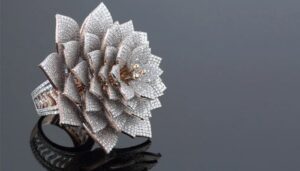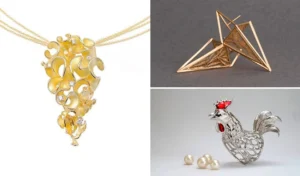The jewellery industry has always been known for its intricate designs and high level of craftsmanship. However, with the advent of 3D printing technology, the industry has been revolutionized. 3D printing has provided jewellery designers with the ability to create custom designs and mass produce them efficiently. In this article, we will explore the role of 3D printing in the jewellery industry for custom designs and mass production.
Overview of 3D Printing
3D printing, also known as additive manufacturing, is a process that involves the creation of three-dimensional objects by layering materials on top of each other. The process involves a 3D printer, which reads a digital design file and uses that information to create a physical object. The printer works by laying down thin layers of material, typically plastic or metal, until the object is complete.
The Role of 3D Printing in the Jewellery Industry for Custom Designs
The ability to create custom designs is one of the most significant benefits of 3D printing for the jewellery industry. With 3D printing, designers can create complex and intricate designs that were previously impossible to achieve. This technology has allowed designers to push the boundaries of their creativity and produce unique pieces that stand out in the market.

Traditional jewellery making techniques involve the use of moulds and casting, which can limit the creativity of the designer. With 3D printing, designers can create their designs digitally, and the printer will produce a physical object that is an exact replica of the digital design. This allows designers to experiment with different shapes, textures, and finishes without the limitations of traditional techniques.
Another advantage of 3D printing in the jewellery industry is the ability to create one-of-a-kind pieces quickly and efficiently. Traditional jewellery making techniques can be time-consuming and expensive, especially when it comes to creating custom designs. With 3D printing, the process is much faster and more cost-effective, making it easier for designers to create unique pieces for their customers.
The Role of 3D Printing in the Jewellery Industry for Mass Production
In addition to creating custom designs, 3D printing has also played a significant role in mass production in the jewellery industry. With 3D printing, it is possible to produce large quantities of jewellery quickly and efficiently, reducing production time and costs.
Traditional jewellery making techniques such as casting can be time-consuming and require a significant amount of labour. With 3D printing, the process is automated, which means that fewer people are needed to produce large quantities of jewellery. This makes it easier for manufacturers to keep up with demand and produce high-quality pieces consistently.
3D printing has also made it possible to produce intricate designs that would have been impossible to achieve using traditional techniques. The level of detail that can be achieved with 3D printing allows for the creation of unique pieces that can be reproduced quickly and efficiently. This is especially useful for manufacturers who need to produce large quantities of pieces with intricate designs.
Advancements in 3D Printing Technology
The role of 3D printing in the jewellery industry is constantly evolving as technology continues to advance. One of the most significant advancements in recent years is the development of high-resolution 3D printers. These printers are capable of producing incredibly detailed pieces, allowing designers to create even more intricate designs.
Another important development is the use of alternative materials for 3D printing. While plastic and metal are the most commonly used materials for 3D printing in the jewellery industry, there are now more options available. Materials such as ceramics, glass, and even wood can now be used to create 3D printed jewellery pieces.
One of the most exciting advancements in 3D printing technology is the use of biocompatible materials. This is particularly relevant in the field of medical jewellery, where patients may require customized pieces to wear during medical treatments. Biocompatible materials ensure that the jewellery is safe for the wearer and does not cause any adverse reactions.
Challenges and Limitations of 3D Printing in the Jewellery Industry
While 3D printing has revolutionized the jewellery industry, there are still some challenges and limitations to consider. One of the main challenges is the cost of 3D printing technology. While the cost has come down significantly in recent years, 3D printers can still be expensive, especially for small jewellery businesses.

Another limitation is the size of the 3D printer. While small-scale 3D printers are widely available, larger printers that can produce bigger pieces are much more expensive. This can be a limitation for jewellery manufacturers who need to produce larger pieces for their customers.
Finally, there is the issue of material limitations. While 3D printing has expanded the range of materials that can be used in jewellery making, there are still limitations to what can be used. For example, certain materials may not be compatible with certain 3D printing technologies, limiting the options available to designers and manufacturers.
Conclusion
In conclusion, 3D printing has had a significant impact on the jewellery industry, providing designers with the ability to create custom designs and mass produce them efficiently. This technology has allowed designers to push the boundaries of their creativity and produce unique pieces that stand out in the market. It has also made it possible to produce large quantities of jewellery quickly and efficiently, reducing production time and costs. As 3D printing technology continues to evolve, it is likely that it will play an even more significant role in the jewellery industry in the future.






